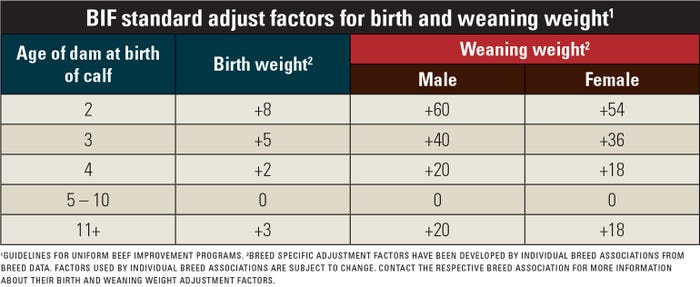
It’ll soon be weaning time; the time to consider making culling decisions since these can have a long-term effect on the competitiveness and profitability of your cow herd.
There are many reasons to cull. Being open tops the list as an open cow will never pay her way out of a lost year of production. Other factors include temperament, age, physical issues (feet and legs), bad udder, bad eyes and frame size.
In this column, I’m going to focus on calf performance. To start, only evaluate calves that are in the same contemporary group — animals of the same sex that are born and raised together.
Metrics to consider
There are several metrics to evaluate a cow based on her calf’s performance:
Weaning weight. This is used to evaluate differences in calf growth rates and the cow’s milk production. This weight should be taken between 150 and 160 days of age.
205-day adjusted weaning weight (aWW). Older calves will likely weigh more than younger calves, but they may not have greater growth potential. For commercial producers, birth weights may not be available. If so, use a standard weight of 75 pounds for males and 70 pounds for females. As birthweight of calves out of different-age cows has been shown to differ, this also should be adjusted.
Finally adjust for the change in milk production at different cow ages. The following table provides that data.


Other metrics that can be used to evaluate a cow include weaning efficiency, the proportion of calf weight to cow weight that gives a measure of the efficiency of the cow; and most probable producing ability (MPPA). Using the weaning weight of her calves over time, this calculates her superiority or inferiority as compared to her herd mates. For this column, I’ll focus on weaning weight.
These values in of themselves are not very helpful in determining what cows to cull. The next step is to compare the individual cow values to the herd average. Called ratios, they are a method of interpreting data by dividing the individual value of interest by the average of the herd:

An animal that has a ratio of 95 weighs 5% less than the average, while one that has a ratio of 120 weighs 20% more than the average. A ratio of 95% is a common benchmark for culling, but you can choose your own benchmark.
The table below can be used to practice calculating the adjusted 205-day weaning weights and ratios. It also serves as an example. Cow 103 is 2 years old and weaned a calf with a 205-day weaning weight ratio of 92%. Cow 46 is a 4-year-old that produced a calf with an 89% ratio.
The temptation would be to keep these cows because they are young and certainly will improve. Remember, though, that each cow had weight added to her calf due to her age — 60 pounds for 103 and 20 pounds for 46.
According to research from … Arkansas, “Most cows ranking in the bottom one-third of the herd for calf-adjusted 205-d BW ratios consistently ranked in the bottom one-third of the herd over a period of several years, regardless of cow age.”

Keep in mind that the above recommendations are based on “all things being equal.” If there are unique circumstances such as health or injury, then some interpretation could be made.
The bottom line is if you have basic data on your cows and calves, you can turn this data into information that can be used to provide guidance in determining what cows to cull.
For more information, search the internet for “BIF Guidelines” and “adjusted weaning weight calculator.”
Baker is a senior Extension associate in the Cornell Department of Animal Science.
About the Author(s)
You May Also Like






